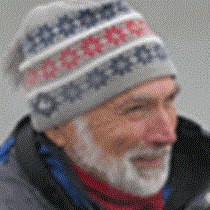Klewnuggit Inlet, British Columbia
A cool misty morning lay like a gray blanket over the land. We anchored sometime during the night and awoke in delicious silence magnified even more by the weather. A complex network of channels and fiords stretched out in all directions. There were numerous places to explore by kayak and Zodiac. As the tide dropped, kayakers paddled through the glassy water and glided into the scenery. A few guests were lucky enough to see a river otter bounding along the beach and inquisitively staring back at them. Although harbor seals showed the same curiosity, they didn’t conjure up quite the same excitement. Barrow’s goldeneyes dazzled us with their incredibly bold and exquisite black and white patterns. The small waterfall pictured in today’s expedition report was particularly scenic. The water level was just not quite high enough to see the lake that stretched out beyond. We contemplated having people stand on top of the Zodiac tube with others on their shoulders but soon agreed that seeing the level of the lake was not that important.
We saw many species of birds as we hiked on the grassy intertidal flat. Golden-crowned, Lincoln’s, song, and savannah sparrows flew between patches of grass, and flocks of western sandpipers glided in and fed quietly. As the monotone calls of varied thrushes drew straight lines on the musical staff, winter wren calls filled the air with cheery musical notes.
The dense forest seemed almost impenetrable when we first peered in. Redcedar bows hung like curtains to be pushed aside, soft branches of western hemlocks added diversity to the aerial tapestry, and the new bright green leaves of blueberries and false azaleas almost seemed to grow independently of their dark branches in the forest understory. Numerous low branches and roots force one to step high. If you don’t, you may trip on a root and fall gently into a soft cushion of caressing mosses. It’s best to take your time getting up from a place like that. It’s quite nice down there.
It’s not only the animals we see and hear that are of interest. Remnants of a dead beaver lay beside the river. In several places large wolf tracks held water in the mud. Wolf droppings contained deer hair and crushed bones. The wild creatures will return to this shoreline again, perhaps soon while we continue our journey north.
A cool misty morning lay like a gray blanket over the land. We anchored sometime during the night and awoke in delicious silence magnified even more by the weather. A complex network of channels and fiords stretched out in all directions. There were numerous places to explore by kayak and Zodiac. As the tide dropped, kayakers paddled through the glassy water and glided into the scenery. A few guests were lucky enough to see a river otter bounding along the beach and inquisitively staring back at them. Although harbor seals showed the same curiosity, they didn’t conjure up quite the same excitement. Barrow’s goldeneyes dazzled us with their incredibly bold and exquisite black and white patterns. The small waterfall pictured in today’s expedition report was particularly scenic. The water level was just not quite high enough to see the lake that stretched out beyond. We contemplated having people stand on top of the Zodiac tube with others on their shoulders but soon agreed that seeing the level of the lake was not that important.
We saw many species of birds as we hiked on the grassy intertidal flat. Golden-crowned, Lincoln’s, song, and savannah sparrows flew between patches of grass, and flocks of western sandpipers glided in and fed quietly. As the monotone calls of varied thrushes drew straight lines on the musical staff, winter wren calls filled the air with cheery musical notes.
The dense forest seemed almost impenetrable when we first peered in. Redcedar bows hung like curtains to be pushed aside, soft branches of western hemlocks added diversity to the aerial tapestry, and the new bright green leaves of blueberries and false azaleas almost seemed to grow independently of their dark branches in the forest understory. Numerous low branches and roots force one to step high. If you don’t, you may trip on a root and fall gently into a soft cushion of caressing mosses. It’s best to take your time getting up from a place like that. It’s quite nice down there.
It’s not only the animals we see and hear that are of interest. Remnants of a dead beaver lay beside the river. In several places large wolf tracks held water in the mud. Wolf droppings contained deer hair and crushed bones. The wild creatures will return to this shoreline again, perhaps soon while we continue our journey north.




